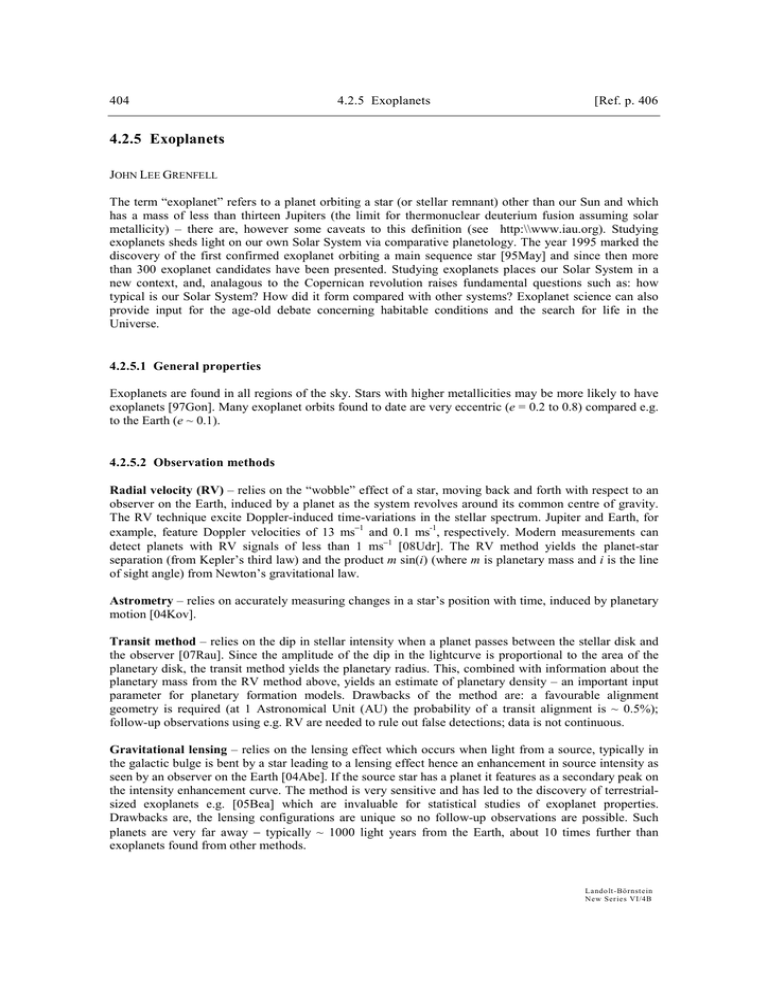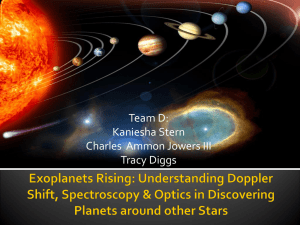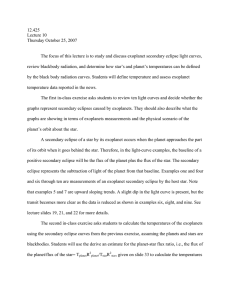4.2.5 Exoplanets
advertisement

404 4.2.5 Exoplanets [Ref. p. 406 4.2.5 Exoplanets JOHN LEE GRENFELL The term “exoplanet” refers to a planet orbiting a star (or stellar remnant) other than our Sun and which has a mass of less than thirteen Jupiters (the limit for thermonuclear deuterium fusion assuming solar metallicity) – there are, however some caveats to this definition (see http:\\www.iau.org). Studying exoplanets sheds light on our own Solar System via comparative planetology. The year 1995 marked the discovery of the first confirmed exoplanet orbiting a main sequence star [95May] and since then more than 300 exoplanet candidates have been presented. Studying exoplanets places our Solar System in a new context, and, analagous to the Copernican revolution raises fundamental questions such as: how typical is our Solar System? How did it form compared with other systems? Exoplanet science can also provide input for the age-old debate concerning habitable conditions and the search for life in the Universe. 4.2.5.1 General properties Exoplanets are found in all regions of the sky. Stars with higher metallicities may be more likely to have exoplanets [97Gon]. Many exoplanet orbits found to date are very eccentric (e = 0.2 to 0.8) compared e.g. to the Earth (e ~ 0.1). 4.2.5.2 Observation methods Radial velocity (RV) – relies on the “wobble” effect of a star, moving back and forth with respect to an observer on the Earth, induced by a planet as the system revolves around its common centre of gravity. The RV technique excite Doppler-induced time-variations in the stellar spectrum. Jupiter and Earth, for example, feature Doppler velocities of 13 ms−1 and 0.1 ms-1, respectively. Modern measurements can detect planets with RV signals of less than 1 ms−1 [08Udr]. The RV method yields the planet-star separation (from Kepler’s third law) and the product m sin(i) (where m is planetary mass and i is the line of sight angle) from Newton’s gravitational law. Astrometry – relies on accurately measuring changes in a star’s position with time, induced by planetary motion [04Kov]. Transit method – relies on the dip in stellar intensity when a planet passes between the stellar disk and the observer [07Rau]. Since the amplitude of the dip in the lightcurve is proportional to the area of the planetary disk, the transit method yields the planetary radius. This, combined with information about the planetary mass from the RV method above, yields an estimate of planetary density – an important input parameter for planetary formation models. Drawbacks of the method are: a favourable alignment geometry is required (at 1 Astronomical Unit (AU) the probability of a transit alignment is ~ 0.5%); follow-up observations using e.g. RV are needed to rule out false detections; data is not continuous. Gravitational lensing – relies on the lensing effect which occurs when light from a source, typically in the galactic bulge is bent by a star leading to a lensing effect hence an enhancement in source intensity as seen by an observer on the Earth [04Abe]. If the source star has a planet it features as a secondary peak on the intensity enhancement curve. The method is very sensitive and has led to the discovery of terrestrialsized exoplanets e.g. [05Bea] which are invaluable for statistical studies of exoplanet properties. Drawbacks are, the lensing configurations are unique so no follow-up observations are possible. Such planets are very far away − typically ~ 1000 light years from the Earth, about 10 times further than exoplanets found from other methods. Lando lt -Börnst ein New Ser ies VI/4B Ref. p. 406] 4.2.5 Exoplanets 405 Direct imaging – involves capturing photons emitted directly by the planet, allowing spectral characterisation. [05Neu] suggested direct image results for a giant exoplanet orbiting at around 55 AU from its star. The Infrared has been suggested as a favourable wavelength region for the direct method, since planets are relatively brighter in this spectral region compared with their central stars, compared with the visible region. Coronograph techniques which involve the blocking-out of interfering starlight in order to analyse with direct imaging the residual, exoplanetary signature, are currently under investigation. 4.2.5.3 Types of exoplanets Hot Jupiters – these are the most common type of exoplanets discovered to-date (http:\\www.exoplanet.eu) although this result most likely reflects a bias in detection methods (large planets with short orbits are favoured for detection). These planets are massive gas giants which orbit very close to their central star. Their discovery sparked a challenge for planetary formation models, to predict how to account for them [05San]. A well-studied example is the transiting hot Jupiter HD209458b (or “Osiris”) where HD refers to the “Henry Draper” catalogue and b (c,d...) refer to planets from inner to outer. Osiris lies about 150 light years away in the Pegasus constellation, orbiting a sunlike star with a period of about 3.5 days and a mass of 0.7 Jupiters. Strong gravitational interaction due to the close proximity of planet and star lead to tidal locking, whereby both planet and star have equal rotation rates and the planet has a constant dayside and nightside. The main atmospheric constituents of hot Jupiters are likely to be molecular hydrogen and helium, although their concentrations have not been measured. [03Vid] determined atomic hydrogen via spectroscopic Lyman-alpha measurements and suggested that Osiris is losing about 10,000 tons per second of its H. [02Cha] detected sodium spectroscopically in the atmosphere of Osiris. [07Tin, 08Swa] discussed spectral signals of water, CO and CH4 in the atmosphere of a hot Jupiter. Thermal brightness measurements of the secondary transit of Osiris (when the planet disappears behind the star) suggested a brightness temperature of 1130 K. A 3D model study of dynamical flow on Osiris was carried out by [03Cho]. The model simulated strong flow from the planet’s dayside to the nightside with large cyclonic flow at high latitudes and global scale atmospheric waves in tropical to mid-latitudes. Terrestrial Exoplanets – refers to a compact body with a core, mantle, crust and a secondary atmosphere formed from outgassing. As detection methods improve, more and more of such planets are expected to be found. Planetary formation models are employed to estimate how common such planets could be, and to shed light on how they form and evolve. [93Lis] provide a review of planet formation. [06Ray] suggest that about one third of known exoplanet systems could contain a terrestrial planet. Important parameters which influence this result include: how quickly the planets accrete in the planetary formation disk and the position and number of gas giants. [07Qui] noted that binary star systems could have habitable planets if the stars remain > 10 AU apart. [00Mor] discuss the delivery of water to terrestrial planets. “Superearth” denotes a terrestrial exoplanet with a mass of up to about 10 Earth masses [07Val; 07Sot]. Attention has focused recently on the red dwarf star Gliese 581 which hosts multiple exoplanets. [07Blo, 07Sel] concluded that one or more of these planets may lie in the “Habitable Zone” (HZ) (see Section 4.2.5.4) although more work is desirable to explore this issue further. Work has focused on the habitability of planets orbiting faint M-stars, which are very numerous in the solar neighbourhood. For such stars, the proximity of the HZ to the star implies tidal-locking of planet and star. In such a case, to be habitable the planet’s atmosphere must be able to transport sufficient heat from the permanentlyilluminated dayside to the nightside, to prevent atmosphere collapse. [97Jos, 03Jos] modelled such a planet and concluded that for > 1 bar CO2 atmospheres the planet would indeed be habitable. [07Sca] reviewed the habitability of planets orbiting M-stars. Additional effects which must be considered are: the influence of flares upon the planet’s atmosphere [07Kho], magnetospheric protection [05Gri], atmospheric escape [07Lam] and photochemistry [07Gre2]. Much effort is being channelled into searching for potentially habitable exoplanets, with particular interest placed in the search for habitable earthlike planets in the HZ. Lando lt -Bö rnst ein New Ser ies VI/4B 406 4.2.5 Exoplanets 4.2.5.4 Terms used in exoplanet research Habitability – the “Habitable Zone” (HZ) [59Hua, 79Har, 93Kas] denotes the region around a star in which a planet must orbit if liquid water (assumed to be essential for life) can exist on its surface. In the Solar system, Venus and Mars lie just beyond the inner and outer HZ boundary, respectively. Biomarkers – denote compounds indicative of life, for example oxygen (from photosynthesis) and ozone (mainly produced from oxygen) and nitrous oxide (from denitrifying bacteria). Other biomarker signatures are e.g. the simultaneous presence of oxidising and reducing gases in an atmosphere (such as e.g. oxygen and methane) which cannot be explained by inorganic chemistry alone [65Lov; 93Sag]. Vegetation (the “red edge”) may also provide a biosignature [e.g. 03Sea]. Model studies [e.g. 93Kas; 02Sel 07Kal; 07Gre1] are employed to calculate theoretical signatures of biomarkers and to rule out “false positives” where inorganic chemistry may mimic a lifelike planet. 4.2.5.5 Missions The French-led COROT exoplanet mission employs the transit approach and can detect down to about two Earth masses. The planned Kepler mission (NASA) will search for earth-sized terrestrial planets orbiting in the HZ. 4.2.5.6 References for 4.2.5 59Hua 65Lov 79Har 93Kas 93Lis 93Sag 95May 97Gon 97Jos 00Mor 02Cha 02Sel 03Cho 03Jos 03Sea 03Vid 04Abe 04Kov 05Bea 05Gri 05Neu 05San 06Ray 07Blo 07Gre1 07Gre2 07Kal 07Kho 07Lam Huang, S.: Am. Sci. 47 (1959) 393. Lovelock, J.E.: Nature 207 (1965) 568. Hart, M.: Icarus 37 (1979) 351. Kasting, J.F., et al.: Icarus 101 (1993) 108. Lissauer, J.J.: Ann. Rev. Astron. Astrophys. 31 (1993) 129. Sagan, C., et al.: Nature 365 (1993) 715. Mayor, M., Queloz, D.: Nature 378 (1995) 355. Gonzalez, G.: Mon. Not. Astron. Soc. 285 (1997) 483. Joshi, M., Haberle, R.M., Reynolds, R.T.: Icarus 129 (1997) 450. Morbidelli, A., et al.: Meteor. Plan. Sci. 35 (2000) 1309. Charbonneau, D., et al.: Astrophys. J. 568 (2002) 377. Selsis, F., et al.: Astron. Astrophys. 388 (2002) 985. Cho, J., et al.: Astron. Phys. J. 587 (2003) 117. Joshi, M.: Astrobiol. 3 (2003) 415. Seager, S., et al.: Astrobiol. 5 (2005) 372. Vidal-Madjar, A., et al.: Nature 422 (2003) 143. Abe, F., et al.: Science 305 (2004) 1264. Kovalevsky, J.: Fundamentals of Astrometry, Cambridge University Press, 2004. Beaulieu, J.-P., et al.: Nature 439 (2006) 437. Grieβmeier, J.-M., et al.: Astrobiol. 5 (2005) 587. Neuhäuser, R., et al.: Astron. Astrophys. 435 (2005) L13. Santos, N.C. et al.: Science 310 (2005) 251. Raymond, S.N., et al.: Nature 313 (2006) 1413. von Bloh, W., et al.: Astron. Astrophys. 476 (2007) 1365. Grenfell, J.L., et al.: Plan. Spa. Sci. 55 (2007) 661. Grenfell, J.L., et al.: Plan. Spa. Sci. 7 (2007) 185. Kaltenegger, L., et al.: Astrophys. J. 658 (2007) 598. Khodachenko, M., et al.: Astrobiol. 7 (2007) 167. Lammer, H., et al.: Astrobiol. 7 (2007) 185. Lando lt -Börnst ein New Ser ies VI/4B 4.2.5 Exoplanets 07Qui 07Rau 07Sca 07Sel 07Sot 07Tin 07Val 08Swa 08Udr 407 Quintana, E.V., et al.: Astrophys. J., 660 (2007) 807. Rauer, H., Erikson, A.: The Transit Method, in Extrasolar Planets. Formation, Detection and Dynamics, Wiley-VCH (2007) 205 Scalo, J., et al.: Astrobiol. 7 (2007) 85. Selsis, F.,et al.: Astron. Astrophys. 476 (2007) 1373. Sotin, C., et al. : Icarus 191 (2007) 337. Tinneti, G., et al.: Nature 448 (2007) 169. Valencia, D., et al. : Astrophys. J. 656 (2007) 545. Swain, M.R., et al.: Nature 452 (2008) 329. Udry, S.: et al.: Transactions IAU 4, Reports on Astronomy 2006-2009, Cambridge University Press, (2008) 316. Lando lt -Bö rnst ein New Ser ies VI/4B







